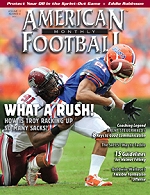Article CategoriesAFM Magazine
|
Flexible Formations – Baldwin-Wallace’s offense is simple to learn but difficult to defend.by: Keith GrabowskiOffensive Coordinator Baldwin-Wallace College © More from this issue Having the ability to align in virtually any formation and easily get the match-ups desired are the main components of our multiple spread offense. In order to have the ability to do this, the offense must have a flexible formation system that gains an advantage in the way that it is taught, so that for the players it is easy to learn and align. Yet, for a defense, it is difficult to defend because of all of the possible match-ups and adjustments. This system accomplishes exactly that because it has the ability to get into multiple personnel groupings, it uses varying types of movement, and it can get into just about any formation that can be imagined. This system de-emphasizes the memorization approach. Many systems require that each player memorize his alignment in every formation call, thus limiting the ....The full article can only be seen by subscribers.
|
|
|||||||
| HOME |
MAGAZINE |
SUBSCRIBE | ONLINE COLUMNISTS | COACHING VIDEOS |
Copyright 2025, AmericanFootballMonthly.com
All Rights Reserved





